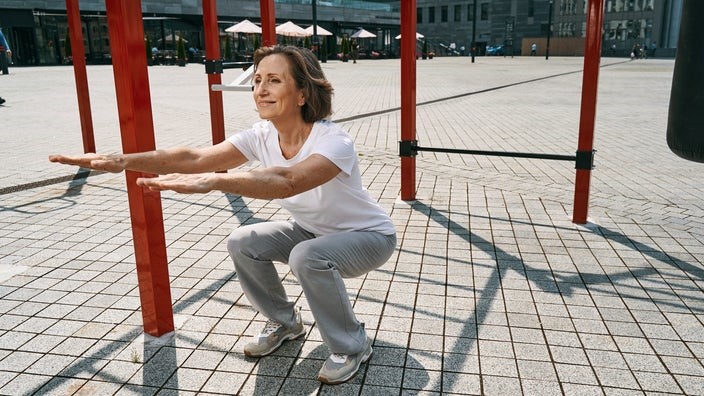Are Squats Bad for Your Knees? Here’s What the Experts Say
Are Squats Bad for Your Knees? Here’s What the Experts Say
Squats are a great lower body exercise, while also being a functional movement needed for everyday activities. But for many people with knee problems, squats can be painful.
While squats are not bad for the knees, they can be irritating if you have certain conditions. Here’s what you need to know about the benefits of squats and how to do the exercise properly to prevent pain.
Are squats bad for your knees?
No, squats are not bad for your knees. They are a great way to build lower body strength. And squatting is a fundamental movement needed for everyday activities and exercise.
But squats put a lot of pressure on the knee joints, which can be painful for certain people. This does not mean squats are bad. But if you have knee pain when squatting, you may need modifications to reduce the discomfort.
Why do my knees hurt when I squat?
Squats put a lot of pressure on the knees while they’re in a bent position. This position exerts a high amount of compression force on the knee joints. These forces can irritate the cartilage within the knees and worsen pain for people with conditions or injuries such as osteoarthritis and meniscus tears.
Increased compression also occurs under the kneecap with deep knee bending. So squats can also irritate conditions, like runner’s knee (patellofemoral pain syndrome), that affect the cartilage under the kneecap. Your leg muscles are meant to absorb some of the compression caused by deep knee bending. But if the muscles are not strong enough, squats are more likely to irritate the knee joints.
Even if you don’t have an existing knee condition, you might feel discomfort if you perform squats with too much added weight or poor form. Your body weight already exerts pressure on your knees when you’re doing squats. So if you decide to add any weight, do so gradually to allow your muscles to build up strength to support the movement.
What are the benefits of squats?
Squats are a great strengthening exercise for your lower body. It’s a movement you do during day-to-day activities, as well as during sports and exercise. There are many benefits of squats, including:
Strengthened leg muscles: Squats are a compound movement. This means that multiplejoints move at the same time when you do them, requiring more muscles to work together. Squats primarilystrengthen your glutes, hamstrings, and quadriceps. All of these legmuscles are important for supporting your body’s everyday movement.
Increased mobility: Squats move yourhips, knees, and ankles through a healthy range of motion. This keeps your joints healthyand mobile to support many types of movements.
Improved function: Performing squats canmake daily activities, such as sitting and standing, easier. This isespecially helpful for older adults and inactive people. In studies,squats have been shown to improveleg function and strength in older adults.
Multiple variations: Squats can beperformed in a variety of ways to make them easier orharder. This allows you to exercise according to your individual activitylevels. Different variations can also keep exercising exciting andchallenging.
How to squat correctly
Avoiding knee pain with squats starts with having good form. We’ve suggested some steps to ensure good form below. But it might also be helpful to do squats in front of a mirror or with someone else to check your form.
To squat correctly:
Step 1: Stand with your feetshoulder-width apart. Keep your body upright with your shoulders back andgaze forward.
Step 2: Brace your core bycontracting your abdominal muscles, and shift your body weight back ontoyour heels.
Step 3: Move your hips back anddown, allowing your knees to bend, as if you are sitting in a chair. Keepyour knees aligned with your ankles.
Step 4: Lower yourself untilyour thighs are parallel to the floor, if possible. Do not round your backor lift your heels up. Only go as low as you can with good form.
Step 5: Keeping your corebraced, straighten your hips and knees to return to a standing position.Maintain an upright posture throughout the whole movement.
Step 6: Complete 8-12repetitions.
As mentioned, you want to make sure that you have proper form when doing squats. Proper form with squatting means maintaining good body alignment from head to toe:
Head: Your head shouldstay neutral, while your gaze should be forward. Don’t bend your neck orextend it up or down.
Shoulders: Keep your shoulderblades pulled down and back with your chest up.
Body: Your body staysupright. You should have a slight arch in your lower back.
Hips: Your hips should staylevel and symmetrical. Don’t tilt your pelvis forward or backward.
Knees: Your knees should stayline with your ankles. Make sure they don’t float forward past your toes,cave in, or push outward.
Feet: Make sure theentire surface of both feet is in contact with the ground. Your feetshould be shoulder-width apart and pointing forward or slightly outward (no more than 10 degrees).
When squatting, your movements should be slow and controlled. Your upper body and lower body should move up and down at the same time.
Many people initiate a squat by bending their knees. But starting a squat this way brings your knees over your toes, increasing the strain through your knee joints. The leg muscles are also less active than they should be when you start a squat this way. This causes much of the pressure of your body weight to be felt through your knees, rather than supported by your leg muscles.



 Tel : +0592 6105769
Tel : +0592 6105769 Fax : +0592 6105769
Fax : +0592 6105769 Email : sales@wuwind.com
Email : sales@wuwind.com